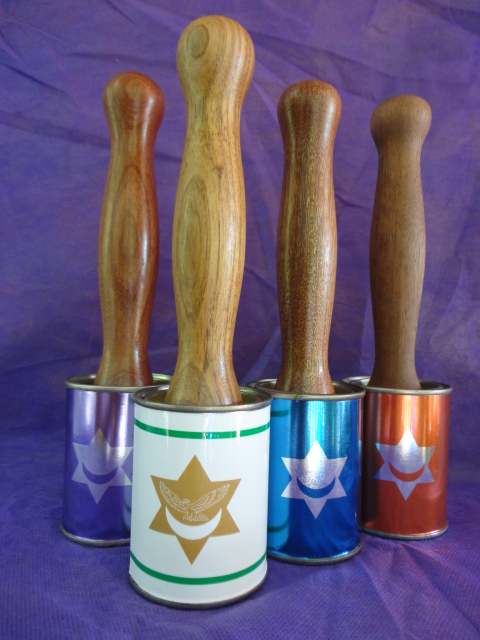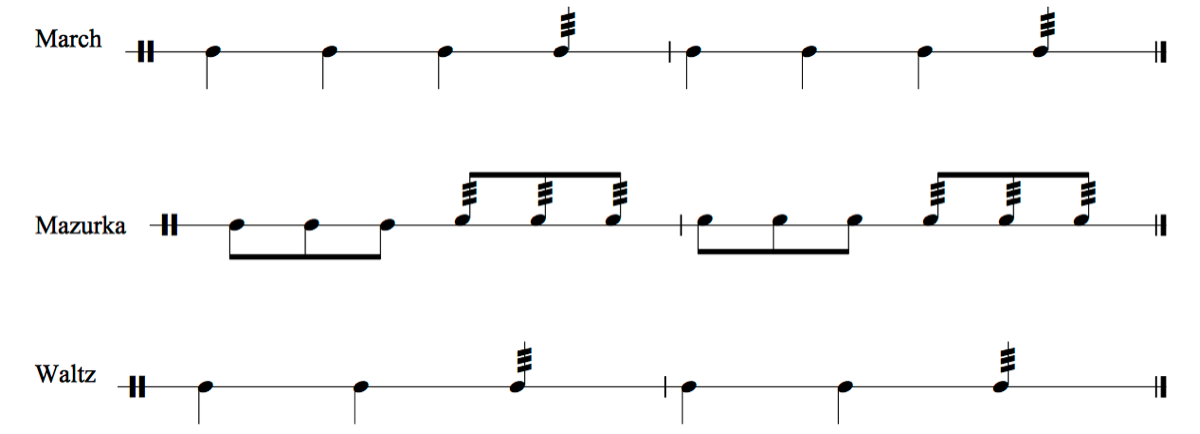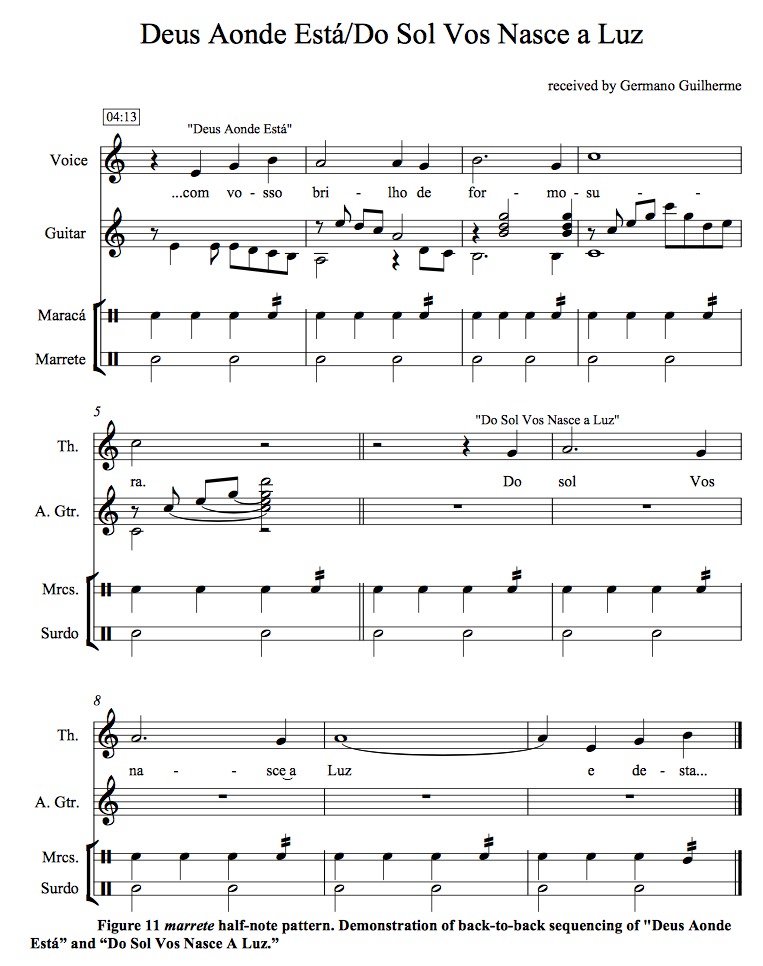
The Maracá
With little exception, there are only three main rhythmic groupings of Daime hymns: march (4/4), waltz (3/4), and mazurka (6/8). The pulse of the marrete kept a half-note pulse on the downbeat and third beat of the march
marcha 4/4
↓👋 – ↓👋 – ↓👋 – ↑
100-150 bpm
110 bpm (marcha lento, ex. "Eu devo amar")
valsa 3/4
↓👋 – ↑ – ↑
90-120 bpm
mazurca 6/8
↓👋 – ↓👋 – ↓👋 – ↑ – ↑ – ↑ (Alto Santo)
↓👋 – ↓👋 – ↓👋 – ↓👋 – ↑ – ↑ (P. Alfredo)
The maracá makes two types of sound, either a downward “tch” or strike played with one hand holding the handle and making a downward motion, or an upward motion trill/roll (rufo).The maracá’s musical role in performing Daime hymns is that of time-keeper, literally beating out the quarter notes. The downbeat is always made with the downward strike and is preceded by an upbeat roll (marked in the example below with upstems).


When waltzes and mazurkas popped up, the marrete half note role turned into a 2-against-3 polyrhythm, playing every other pulse in a two-bar metric pattern. In this way, the marrete sonically plays the unique role of being the only polyrhythm in the performance practice of Santo Daime.
It is known that Mestre had many difficulties presenting the instrument to his group of followers, in the development of his doctrine, as attests Jairo Carioca’s account, who tell us: “Its introduction in the hinário services, as the elders affirm, was one of the most difficult tasks that Mestre Irineu faced. ‘Even I, many times, didn’t have patience to rehearse and would step out of the form. One time I got so irritated that I threw the maraca on the table and said that I wouldn’t dance anymore’, remembers Mrs. Percília Matos. Since then starts to occur the doctrine rehearsals. Mestre Irineu started to gather the group on the weekends and on a patiently way “He would teach us one by one how to dance, many times grabbing us by the hand and showing the steps that had to be done in accordance with what the Queen was asking of him.” From what we know, it took almost six months of intense rehearsals until the ideal form of bailado instructed by Mestre Irineu was ideally executed”.
Below, the priceless words of Daniel Arcelino Serra about the maraca,
according the teachings transmitted by Mestre Irineu, including his way of playing it.
The maraca, that was the first instrument that he received from the Queen, was the following: it had rehearsal for people who wanted to learn. There are people who want to extinguish the maraca in the works, and that is wrong.
The maraca is beat on the palm of the hand; this way he instructed [Mestre]. The maraca is not used only in the concentration works. Not even the leader plays it. The New Hymns [Cruzeirinho of Mestre], for example, are sung standing and without instruments [concentration works]. The concentration lasts three hours – two hours of silence and one hour for the New Hymns. Regarding the seated works, many times we did seated works using maraca. In this time Mestre did the “circling hinários”, where we went from house to house to hold the works. Each day in the house of a brother.
Regarding the chiming*, he [Mestre] used occasionally, when the rhythm and the tempo inside the works allowed. The chiming is allowed, since not muddling the musicians, because it can interfere too much. It has to be within the tempo of the work.
Mestre** used a milk can [500g], of those big ones, and the rest of the group used the average size, and with time people started to copy him. João Nica, from the Centro Rainha da Floresta (Forest Queen Center), in Alto Santo, uses these giant cans still today.
*a double beat (very close together) when the turn of the tempo / bailado.
**answer given to the comment of Eduardo Bayer, asking Daniel Serra "if in the time of Mestre the standard size used in Alto Santo was that giant maraca made of a milk can, or if there was a normal size can". Where he complements the question: "It seems that the big maraca was only the one of Mestre, due to his size [6.56 feet tall], isn't it Mr. Daniel?"
Below, the priceless words of Daniel Arcelino Serra about the maraca,
according the teachings transmitted by Mestre Irineu, including his way of playing it.
The maraca, that was the first instrument that he received from the Queen, was the following: it had rehearsal for people who wanted to learn. There are people who want to extinguish the maraca in the works, and that is wrong.
The maraca is beat on the palm of the hand; this way he instructed [Mestre]. The maraca is not used only in the concentration works. Not even the leader plays it. The New Hymns [Cruzeirinho of Mestre], for example, are sung standing and without instruments [concentration works]. The concentration lasts three hours – two hours of silence and one hour for the New Hymns. Regarding the seated works, many times we did seated works using maraca. In this time Mestre did the “circling hinários”, where we went from house to house to hold the works. Each day in the house of a brother.
Regarding the chiming*, he [Mestre] used occasionally, when the rhythm and the tempo inside the works allowed. The chiming is allowed, since not muddling the musicians, because it can interfere too much. It has to be within the tempo of the work.
Mestre** used a milk can [500g], of those big ones, and the rest of the group used the average size, and with time people started to copy him. João Nica, from the Centro Rainha da Floresta (Forest Queen Center), in Alto Santo, uses these giant cans still today.
*a double beat (very close together) when the turn of the tempo / bailado.
**answer given to the comment of Eduardo Bayer, asking Daniel Serra "if in the time of Mestre the standard size used in Alto Santo was that giant maraca made of a milk can, or if there was a normal size can". Where he complements the question: "It seems that the big maraca was only the one of Mestre, due to his size [6.56 feet tall], isn't it Mr. Daniel?"
